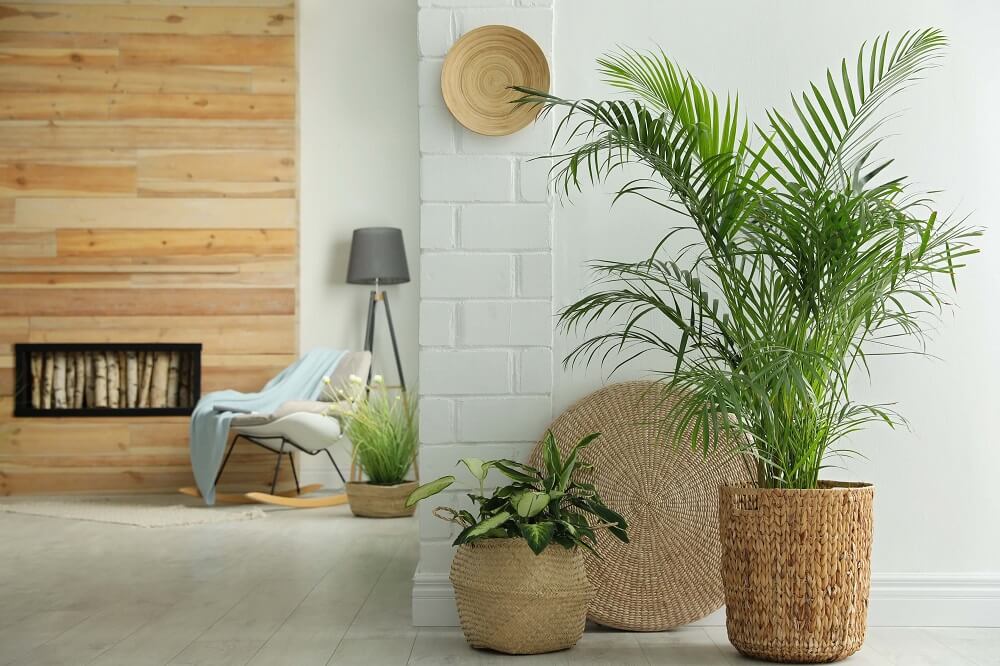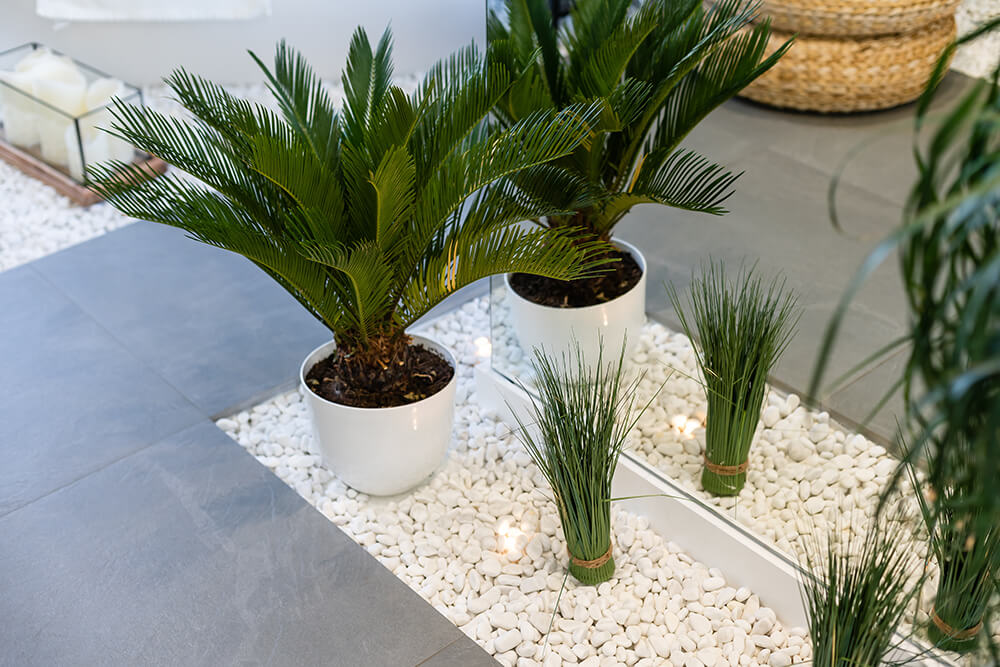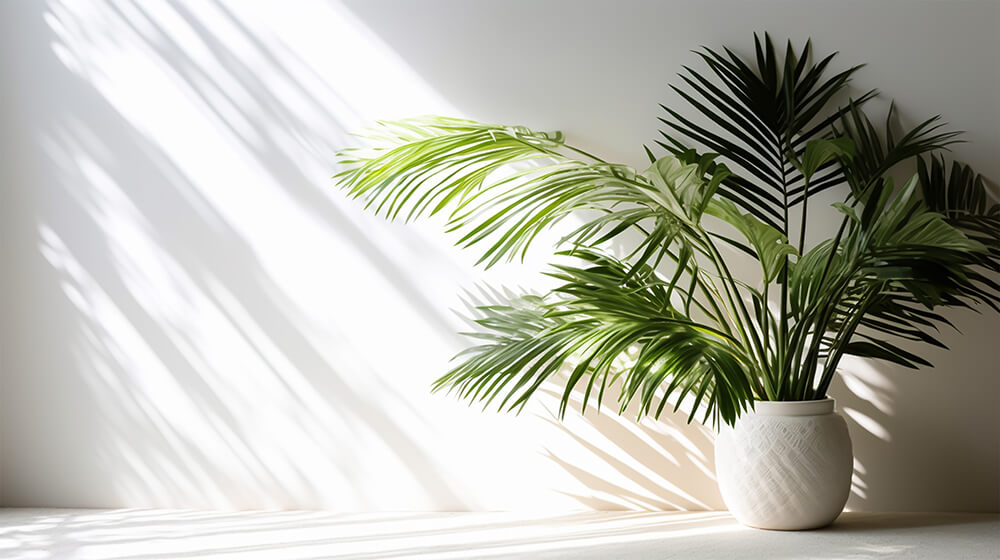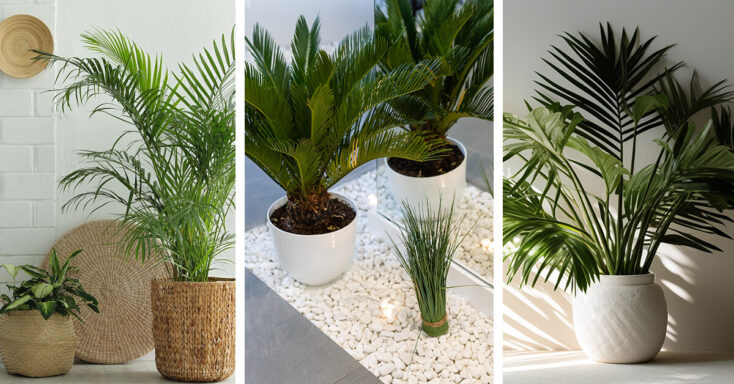Palm trees originate in tropical and sub-tropical environments. It’s easy to recognize them, with large, showy leaves (called fronds). The fronds decorate the top of a palm like a glorious hairdo. Did you know you can grow and care for palm trees indoors? It’s just a matter of learning about the needs of the palm like you would any indoor plant.
A Tropical Reprieve
Palm trees have 2,600 species. In their grandeur, they have an important role as landscape trees. But that doesn’t keep palm trees from coming indoors. In fact, you’ve probably seen palms in spaces like foyers. The smallest varieties are ideal for adding a unique, vibrant green focal point to your home.
When you visualize palm trees, you probably think of sunshine and beaches. But don’t let that deter you. If you choose the right palm tree, growing it successfully indoors isn’t overly difficult. And don’t worry about one growing through your roof. They are very slow growers. Parlor palms, for example, top out at around 2-6 feet tall when planted in your home.
Key Takeaways
- Certain varieties of Palm Trees are suitable for growing indoors
- Indoor palm tree care isn’t difficult
- Palm trees grow slowly, so be patient
- Your indoor palm will benefit from wiping down the leaves periodically with a damp cloth
Palm Tree Symbolism
In the Mediterranean world, palm fronds represent long life, peace, overcoming, and victory. In Greece, athletes often received a palm leaf representing their triumph. Their Sun God, Apollo, was born under a palm tree.
Christianity speaks of Jesus’ entry into Jerusalem, welcomed by palm leaves (and thus Palm Sunday). In Islam, palms have associations with Paradise. Assyrians regarded it as a sacred tree (the top connecting to heaven, while the trunk remains on earth). Egyptians carried palm fronds in funeral processions as a symbol of eternal life.
Frequently Asked Questions About Indoor Palm Tree Care
Should I prune my palm tree?
Stop! Don’t trim that frond. Many palm tree species can draw nutrients from those old fronds even if they’re yellow. Over-pruning can weaken your plant. Remove only fully brown leaves.
How do you take care of an indoor palm tree?
It’s easy to provide palm care indoors. Palm trees are low maintenance. Provide them with healthy soil and indirect light. Try to place them in an area with cold drafts (including your air conditioning unit). Never cut off the palm’s top because they grow from the central tip.
How often do you water an indoor palm tree?
A settled indoor palm tree should be watered 2-3 times a week, but always check the soil. The first 1-2 inches should be dry. New indoor palms will need water every day during the first week, then every other day during the second week. Come the third week, water them 3 times as you would a settled plant.
Why is my indoor palm plant turning brown?
Lack of water and dry air can result in browning leaves. If you have a humidifier, give your plant some time with it weekly. Otherwise, mist it using a spray bottle. Other potential scoundrels causing brown leaves include root rot and over-fertilizing.
Do indoor palms like the sun?
In a word, no. Keep your indoor palms out of direct sunlight. Instead, look for an area offering partial shade. They don’t mind low light but still need those warm rays. So it’s a balancing act. Note that indoor palms will die in total darkness.
Should I cut off brown palm leaves?
If the tip of the leaf is brown let it be. It could be a sign of temporary stress. You can remove fully brown or dry fronds. Just don’t go crazy. Your indoor palm should never receive trimming just for ornamental reasons.
What does an overwatered palm look like?
If you notice your palm’s fronds slowly turning yellow, that’s one sign of over-watering. Other indicators include wilting fronds and droopy leaves with brown tips. You can remove it from the pot and find another vessel with better drainage.
10 Pointers for Indoor Palm Tree Care
1. Indoor Palm Tree Types
Some palm tree types are far more suited to living inside with you. Here are a few ideas:
- Areca Palulm: If you have high ceilings (such as in an entryway), these 6-foot-tall palms have slender leaves. Slow growing.
- Bamboo Palm: Tolerates low light. Broad, curving leaves.
- Dwarf Chinese Fan Palm: Beautiful star-shaped leaves. Slow growing, reaching about 30” tall.
- European Fan Palm: Green-gray fronds measure 2 feet across. A dependable indoor palm.
- Miniature Lady Palms: Very durable. Grows to 4 feet.
- Parlor Palm: Reputed to be the easiest indoor palm tree in terms of care. They were highly popular in Victorian parlors.
- Pygmy Date Palm: Reaches 3 feet high, It has feathery leaves. Very adaptable.
What, no coconuts? Not every palm tree grows coconuts. Among the fruit-bearing palms, there are dates and acai berries. These are edible. If you come across palm fruit, check the type first. Some are poisonous.

2. When to Plant Indoor Palms
If you follow nature’s cue, the best time to plant indoor palms is spring and early summer. If you live in a cold region, it gives your plant time to establish roots should it be exposed to cold air.
Not Just Another Pretty Face
While Palm Trees are truly a lovely site, palm trees have other uses than modeling for us. The trees go into producing oil, lumber, drinks, and woven materials. The wood becomes building materials. For the home, palm provides practical items for your home, like a broom and wax for candles, cosmetics, and soap.
3. How to Plant Indoor Palms
While it takes some time, the best way to plant indoor palms is to start with a seed. To sprout a seed, place it 4 inches deep in the soil. The pot does not have to be the one you’ll finally use. Move the pot to a humid, warm part of the house. Wait about 2-4 months.
Once the seed sprouts, move the container to an area with indirect light. Full sun can burn the fronds. Give it a reduced fertilizer. When the plant grows several leaves, it’s time to put it into your planned pot.
Put a layer of potting mix into the container. You’ll have to eye this. Ultimately you want your baby palm nesting about 2 inches below the crock’s lid. Gently tap the soil for support.
In the palma of your hands: in Latin, the term for the palm of your hands is “palma.” The word reflects the shape of its leaves, looking much like fingers on an open hand. The spelling remained in Old Saxon Old High German. The Norse put an “r” on the end (“palmr”).
4. Container Planting Fundamentals
Depending on how big your indoor palm tree grows, you’ll usually need a 3-5 gallon pot. It needs to be twice as wide as it is tall. Why? Because, unlike some plants, indoor palms’ roots grow horizontally.
You don’t have to be overly worried about soil types. As long as the dirt is loose, you’re good. If you can find a soil blend with peat moss, that’s awesome. One ideal example is cactus or succulent soil mix.
Put a Ring on It
When you look at a slice of wood, you can count the rings to tell its age. Well, indoor palms like to be distinct. Instead of rings, the wood has circular vessels. The tree produces the vessels, so it thickens. So, the only real way to determine an outdoor pine tree’s age is by investigating its history.
5. Indoor Palm Tree Care

When considering proper indoor palm care, there are five essentials.
- Fertilizer: Your local greenhouse store should carry palm fertilizer, which contains potassium and manganese. These two vitamins are essential for a healthy indoor palm tree.
- Lighting: Your indoor palm doesn’t mind the shade. They may not thrive in direct sunlight. If you have an area with indirect light, that befits the palm perfectly.
- Soil: Look for succulent soil. If not, just reach for the tried-n-true, all-purpose potting soil.
- Temperature: Some indoor palms, like the parlor palm, can develop in the cold. On average, indoor palms prefer temperatures above 50 F.
- Water: Your palm needs drainage to remain healthy. Think about this when choosing a pot. Never let your plant’s roots sit in water. Wait until the soil dries out before watering.
Look up in the Sky, it’s a Bird. No… it’s a…..Palm Tree?
Palm trees like Quindio Wax Palm can reach as high as 200 feet. Mexican Fan Palms come in second at 100 feet. Besides breaking records for height, some palm trees have hefty seeds. The Coco de Mer seeds are 60 pounds each, measuring 20 inches in diameter.
6. Potting and Repotting
So long as you have a 3-5 gallon container with good drainage, the proper soil, and a partial-light location, potting your indoor palm tree is a breeze. Many green thumbs advise putting some pebbles in the container’s base before adding soil to help with drainage. When you put the plant into the soil, the trick is to make sure you situate the root ball so the sprout is about 2 inches down from your flower pot’s rim.
Good news! Indoor palm trees only need repotting around every 2-3 years. Palms don’t take to repotting well, so only change pots when necessary. One cue from your palm is seeing roots around the rim of the container. Time to grow!
As indoor palms get older, they’ll need a heavier pot to support the plant. Try not to pull the palm out. Rather, break the original container to protect the root ball. It doesn’t hurt to use fresh soil. Beyond that, follow all the potting rules.
Palm trees in time’s past: Fossil records tell us that palm trees appeared in the Cretaceous period (144-65 million years ago). For the past 5,000 years, people cultivated it, starting with Mesopotamians. They used palmwood for tool making and building homes.

7. Wintering
If you put your indoor palms outdoors for the summer, such as parlor palms, you’ll find they happily move back into the house with little trouble. Lightly clean the leaves off with a damp cloth to combat accumulated dust. This is the perfect opportunity to examine the plant for spider mite damage.
Water your indoor palm about every 3-4 weeks during winter.
Up on the Rooftop
Utilizing the space on top of a house for gardening is a growing trend. You want heavy pots so the palm doesn’t fall over! Don’t put them out in full sunlight. You may have to watch the shadows on your roof for a day before planning positioning.
8. Indoor Palms’ Common Pests and Diseases
The bane of all gardeners are pests and diseases. The problems often get too bad to treat the plant. So, if you recognize an issue with your palm, do what you can to nip it in the bud.
Pests
While your palm tree is of a hardy lot, it can be susceptible to some insects and maladies. By far, the worst culprits for attacking your plant are spider mites. Increased humidity helps fight them. You may encounter mealy bugs once in a while, but not commonly. For a pet-friendly treatment, get neem oil.
Disease
Ganoderma Root Rot lives in the soil. So if you got a potted palm, it may already be exposed to this disease. Symptoms include withering older fronds. New growth comes out yellowish or light green. In the worst-case scenario, the whole op may fall from the trunk. Once you notice this, you have 2-3 years before the palm dies. Unfortunately, there are no cures. If you plan to let it grow until the end, make sure you throw out the soil, too.
Fungus is a common disease that makes palms sick. You’ll see spots and frond lesions as a symptom. Thankfully, all you need is a copper fungicide. Get rid of any sick leaves, and make sure your plant has good air circulation.
Nutrition
People sometimes think their plant is dying from a disease or infestation when it simply needs a mineral boost. Indoor palms often suffer from 3 nutritional issues stemming from low
- Magnesium
- Manganese
- Nitrogen
If you have a college cooperative near you with any Botany courses, give them a call to see if you can get your soil tested. You can also follow an annual fertilization schedule. Fertilize three times during the growing season (April-September). Look for a fertilizer marked 8-2-12-4 (N, P, K, Mg). Follow the instructions for use. An alternative is 12-4-8 fertilizer, applied twice during the growing season.
Palm tree tradition: While some people grow a palm tree or two on their roof as part of the garden, there may be another reason for its presence. For centuries, topping a roof with a palm tree has been a tradition. Once the structure’s final beam goes into place, so does the palm tree.
9. Common Growing Problems
There are few problems to worry the owner of an indoor palm. You may get root rot from poor drainage or over-watering. If your plant was exposed to temperatures beneath 45 °F for some reason, it can stunt growth.
Over-fertilization causes lower leaves to turn brown. So watch how much you give your plant. Never put a saucer under your palm’s container. It will hold water that can drown the plant.
Cheers!
In certain parts of Africa, you can find a wine called Kallu. It’s created from date palms or coconut palms as a refreshing beverage.
10. Heart of Palm
The inner core and flower of certain palm trees, often coconut, is a vegetable. It tastes a bit like an artichoke. They’re good salad ingredients or additions to soup and stew. You can marinate and grill them, or use them in stir fry, too.
Which is Which? The male palm tree has no visible flowers and the trunk has no fronds. The female palm tree has rosette-looking leaves. It flowers near the top of its trunk.
10 Guides for Growing Palm Trees in Your Home

Having an indoor palm tree makes for a great conversation piece. It brightens up neutral spaces with vibrant green. You’ll have little trouble growing an indoor palm as long as you follow proper palm tree care guidelines. Three things: make sure you don’t overwater the palm, place it in partial light, and keep an eye out for spider mites.



